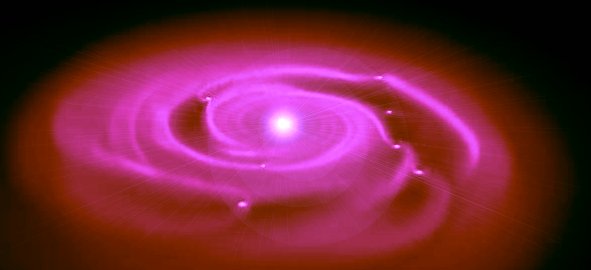
The Tiniest Star
The astronomer Kevin Luhman has announced findings about the tiniest star yet known. This object is forming its own planetary system in a similar way to 'normal' stars.

However, the difference is that this tiny star is just 8 times bigger than Jupiter.
"A team led by Kevin Luhman, assistant professor of astronomy and astrophysics at Penn State University, will discuss this finding in the 10 December 2005 issue of Astrophysical Journal Letters.
The discovered object, called a brown dwarf, is described as a "failed star" because it is not massive enough to sustain nuclear fusion like our Sun. The object is only eight times more massive than Jupiter. The fact that a brown dwarf this small could be in the midst of creating a solar system challenges the very definition of star, planet, moon and solar system.
"Our goal is to determine the smallest 'sun' with evidence for planet formation," said Luhman. "Here we have a sun that is so small it is the size of a planet. The question then becomes, what do we call any little bodies that might be born from this disk: planets or moons?" If this proto-planetary disk does form into planets, the whole system would be a miniaturized version of our solar system -- with the central "sun", the planets, and their orbits all roughly 100 times smaller." (1)
This discovery lends tremendous support to much of my writings over the last few years. I have argued for a sub-stellar class of objects below the 13 Jupiter-mass cut-off point traditionally applied to the bottom end of the brown dwarf spectrum. These dark stars are quite bright when they initially form. However, they soon use up much of their fuel and become dark, relatively cold objects.
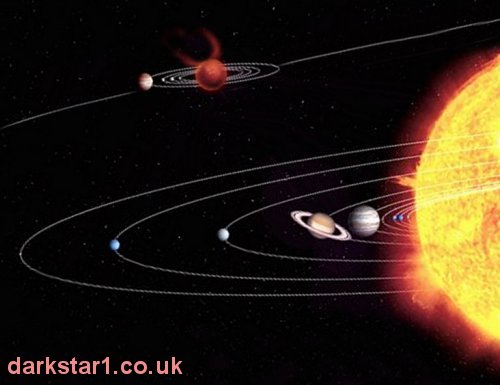
Yet, they maintain certain stellar characteristics, including a dense and complex atmosphere capable of much volatility. This produces flaring, aurorae and the emission of high energy radiation, like X-rays.
Furthermore, these 'sub-brown dwarfs', whose specific character has yet to be labelled appropriately by the scientific community, are capable of having their own miniature planetary systems. This latest discovery builds on the already growing evidence in support of this overall picture. Sub-brown dwarfs are a class of stars, not planets. Once an object becomes several times the mass of Jupiter, it takes on a different set of characteristics from out familiar gas giant. It becomes a Dark Star.
"The science team
spotted Cha 110913-773444 about 500 light years away in the constellation
Chamaeleon. This brown dwarf is young, only about 2 million years old, they
said. In the past decade, advances in astronomy have led to the detection of
small brown dwarfs and massive extra-solar planets, which has brought about a
quandary in how to classify both.
“There are two camps when it comes to defining planets versus brown dwarfs,”
said team member Giovanni Fazio of the Harvard-Smithsonian Center for
Astrophysics. “Some go by size, and others go by how the object formed. For
instance, this new object would be called a planet based on its size, but a
brown dwarf based on how it formed.” "
(2)
In
other words, astronomers are struggling to figure out a way of classifying these
objects. Whatever name you may feel applies to them, the fact is that they
are real enough. I believe that there is just such an object in orbit
around the Sun, albeit one that is significantly older, and much darker than Cha
110913-773444.
The evidence for the existence of such an object is laid out in some detail in my book 'The Dark Star', recently publisher by Timeless Voyager Press.
If I am right then this latest discovery enhances the possibility that our own Dark Star would have a system of planets. This system is binary to our own Sun, and provides us with the wonderful possibility for further life in the peripheries of our Solar System.
The Tiniest Planet
It seems like we are only just starting to appreciate the variety of stars out there, as well as cross-over star/planets which we call brown dwarfs. Objects more familiar to us are making the news too, though.
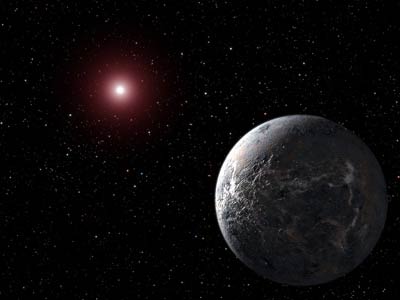
An extra-solar planet which is several times as massive as the Sun has been discovered in a distant star system. It is the first of its kind and paves the way for many new and exciting discoveries in the coming years:
"Using an armada of telescopes, an international team of astronomers has found the smallest planet ever detected around a normal star outside our solar system. The extrasolar planet is five times as massive as Earth and orbits a red dwarf, a relatively cool star, every 10 years. This artist's illustration shows an icy/rocky planet orbiting a dim star. The distance between the planet, designated OGLE-2005-BLG-390Lb, and its host is about three times greater than that between the Earth and the Sun. The planet's large orbit and its dim parent star make its likely surface temperature a frigid minus 364 degrees Fahrenheit (minus 220 degrees Celsius." (3)
Fans of Zecharia Sitchin will note that the size of this planet correlates with the often proposed size for the planet Nibiru, of approximately 5 Earth masses. So at least we now know that such a size is possible for a planet. This new discovery is also frigid, like 'Nibiru' would be if it lacks the warmth of a parent brown dwarf for company.
Mainstream Astronomer Advocates Dark Star Scenario
Astronomer Paul Kalas has studied proto-planetary discs around extra-solar planets and is joining the growing number of astronomers now convinced that our own Kuiper Belt shows signs of the existence of a hidden binary companion to the Sun.
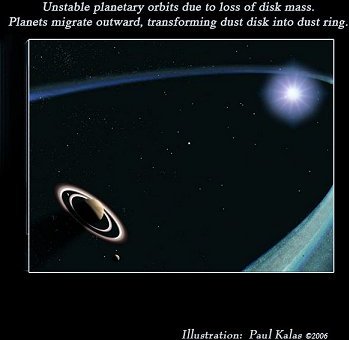
Where the Dark Star Theory may appear highly speculative to many, perhaps even nonsensical, it seems as though professional astronomers are becoming increasingly convinced that this object may be for real! What Paul's proposing is roughly the same as the scenario laid out in my book 'The Dark Star'.
"Kalas and Graham speculate that stars also having sharp outer edges to their debris disks have a companion—a star or brown dwarf—that keeps the disk from spreading outward, similar to how Saturn's moons shape the edges of some of the planet's rings. The story of how you make a ring around a planet could be the same as the story of making rings around a star," Kalas said. Perhaps a passing star ripped off the edges of the original planetary disk, but a star-sized companion, remaining in place, would be necessary to keep the remaining disk material from spreading outward, he figures. The scenario has Kalas and his colleagues thinking that the Sun might also have a companion that keeps the Kuiper Belt confined within a sharp boundary. U.C. Berkeley physics professor Richard Muller has proposed such a star, which he calls Nemesis, but no evidence has been found for one."
(4)The problem with drawing parallels between what is going on in the outer Kuiper Belt region and the existence of a Nemesis object as proposed by Muller et al is that these two parts of the solar system are vastly different terrains. Muller's proposed object is out in the outer Oort Cloud, way too far away to have any affect upon the relatively neighbourly Edgeworth-Kuiper Belt. Yet when one discusses Dark Star companions one is immediately reminded of the original Nemesis proposition, which is a significantly important idea in the history of Planet X research.
But this proposed companion object would need to reside very much closer to the planetary zone of the solar system to create the effect in the Edgeworth-Kuiper Belt which Paul Kalas, amongst others, is mulling over (5). I suspect such an object lies between the Edgeworth-Kuiper Belt and the inner Oort Cloud, making it a highly desirable target for discovery in the near future. More details in my book (see below).
Common Binaries
For years we have all been told that the most common type of star system is a binary, where two stars orbit around a common centre of mass in reasonably close proximity. Our Sun, therefore, is part of a minority community in that it appears to be alone. As astronomers have become more adept at finding smaller and smaller stars that picture may be changing. The M-class of star, known as 'red dwarfs', are proper stars, although considerably smaller in size than our Sun. The population of these types of stars is now known to be very common, and they appear to be mostly singular in nature.
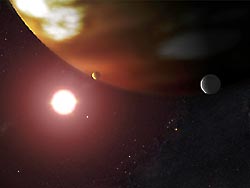
As a result, the statistical populations of known stars have shifted towards singular rather than binary. But this is just a statistical trick because of the fact that red dwarfs make up the majority of stars. If you look at larger stars, like our Sun, the binary rule still applies (6).
The other complication to bear in mind is that our appreciation of the populations of brown dwarfs is in its infancy. Brown dwarfs, which are considerably smaller than even the red dwarfs, may turn out to be just as common. Not only that, but it may be found that there is a huge swath of companions to all classes of star that take the form of these tiny brown dwarfs.
Thus, the vast majority of systems may turn out to be multiple star systems, with a main star accompanied by one or more brown dwarfs in wide orbits. Such a scenario may still be true of our own Sun, a situation which would go a long way towards explaining the enigmatic features of the outer solar system.
Written by Andy Lloyd, 1st December 2005- 1st February 2006
author of 'The Dark Star' (2005), 'Ezekiel One' (2009), 'The Followers of Horus' (2010) and 'Darker Stars' (2019),
Published by Timeless Voyager Press
References:
1) SpaceRef.com "Scientists Find Possible Birth of Tiniest Known Solar System" 29 November 2005, with thanks to David Pearson
2) Penn State and Harvard-Smithsonian Centre for Astrophysics Press Release, 29 November 2005, with thanks to Brant McLaughlin and Nick Lambert (no longer available online)
3) Hubble Site "Astronomers Find Smallest Extra-solar Planet Yet around Distant Star" 25 January 2006, with thanks to Rob Solarion, and Blue Peter!
4) Space.com "Star Systems Hint at Possibility of Sun's Nemesis" 19 January 2006
5) Robert Sanders "Two new dusty planetary disks may be astrophysical mirrors of our Kuiper Belt" 19 January 2006, with thanks to David Pearson
6) R. Naeye "Surprise! Most Stars Are Single" Thanks to David, Brant, Liz, Peter & Greg